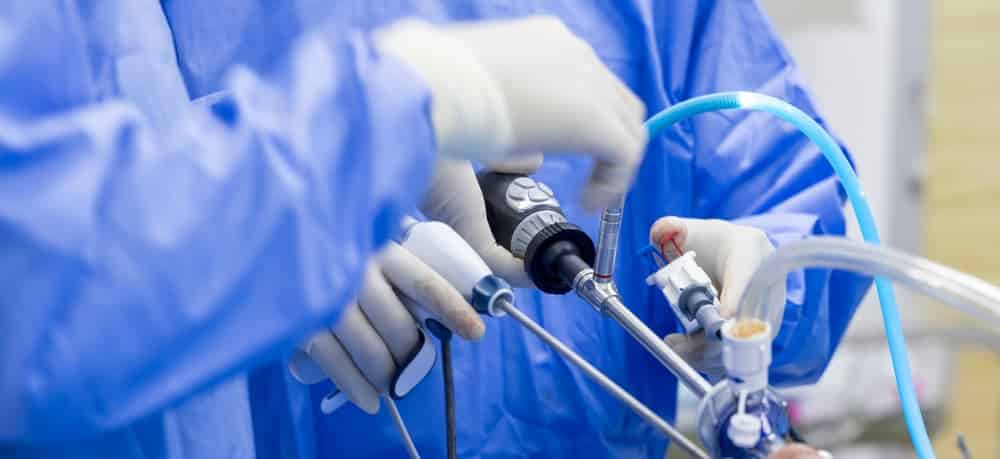Although shoulder arthroscopy is minimally invasive in nature, it is still a surgery like any other. The good news is that if you follow a series of instructions given to you by your surgical and treatment team, chances are your recovery after shoulder arthroscopy will be quick and you'll be back to everyday life sooner than you think.
Table of contents
What is shoulder arthroscopy?
Shoulder arthroscopy is a minimally invasive surgical procedure that uses a tiny camera called an arthroscope to examine or repair the tissues inside or around your shoulder. The arthroscope is inserted through a small incision in your skin. This camera projects pictures of your shoulder joint to a video screen. Your surgeon looks at the images to find the source of your injury. One or two further small incisions are made to insert instruments in order to address/repair the pathology inside your shoulder. Each incision is about the size of a keyhole (4mm). You might have arthroscopy for rotator cuff tears, shoulder impingement or shoulder instability (dislocated shoulder). Minimally invasive procedures require smaller incisions than traditional surgery. They allow the surgeon to address more accurately any pathology encountered. They allow for faster healing, shorter hospital stay and less postoperative pain.
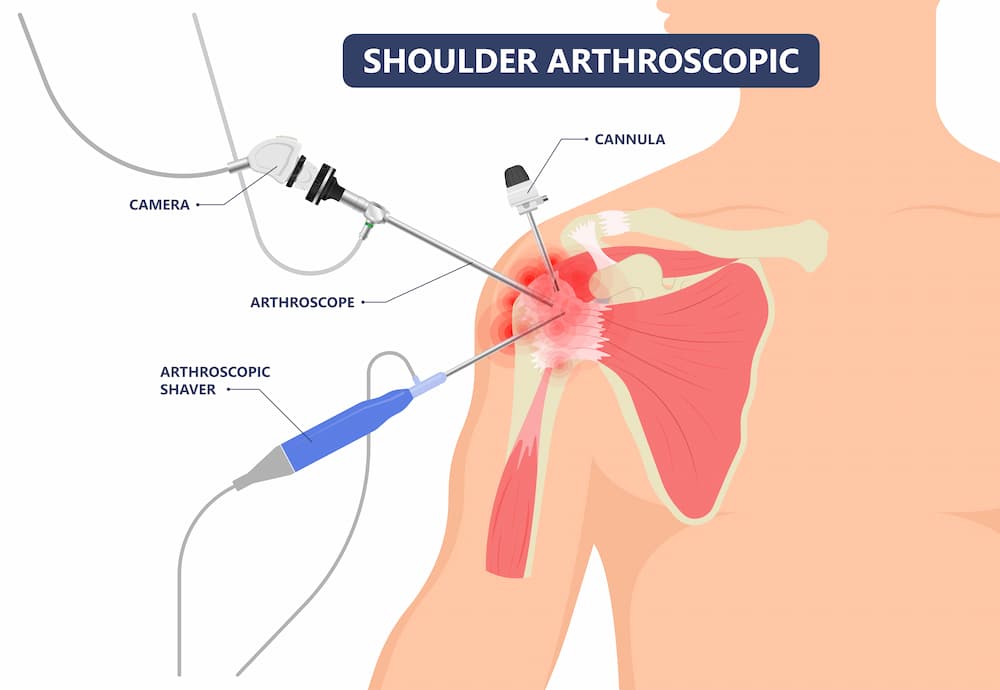
What conditions are treated with shoulder arthroscopy?
Shoulder arthroscopy can treat problems such as:
- Impingement syndrome – supraspinatus tendonitis
- Rotator cuff tears
- Calcific Tendonitis
- Frozen Shoulder
- Shoulder instability
- Biceps pathology - SLAP tears
- Early osteoarthritis
- Acromioclavicular joint pathology

What are the advantages of shoulder arthroscopy?
- No admission is required - you can return home the same day
- Better visibility of the anatomical structures - better accuracy.
- Complications are much less common than with open surgery (infection, bleeding, etc.).
- Postoperative pain is less, as the surrounding tissues have not been disturbed
- Quicker patient recovery
- Faster return to work & everyday activities
- Smaller incisions - better cosmetic result.
Read more on the advantages of shoulder arthroscopy.
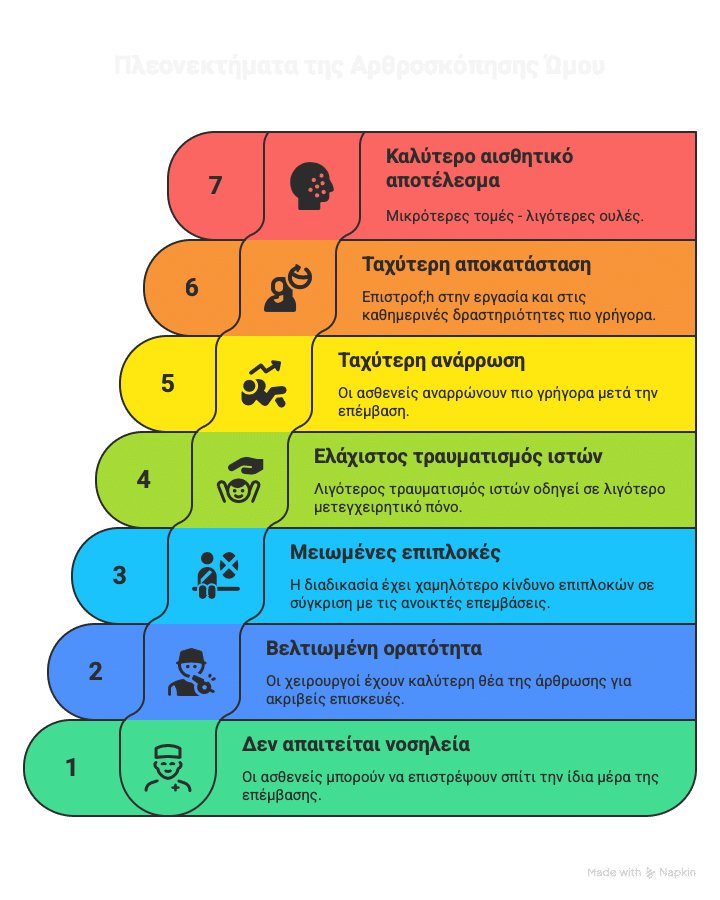
After the procedure
After your operation, you will be transferred to recovery, the area near the operating room. Here, the recovery nurse will take care of you as you wake up. They will make sure that your vital signs are satisfactory, that you feel comfortable, and can give you additional painkillers if required. Once you fully "wake up" and when the nursing staff is happy, you will be transferred back to your room, to the ward.
In the ward, after surgery, your recovery will be checked regularly by the ward nurses. You will be visited by your physiotherapist, anaesthetist and me. We will probably tell you a lot of details and give you a lot of information, which you may not fully retain. Don't worry, everything will be repeated and organized for you during your stay, while you will also be given detailed instructions when you leave the hospital.
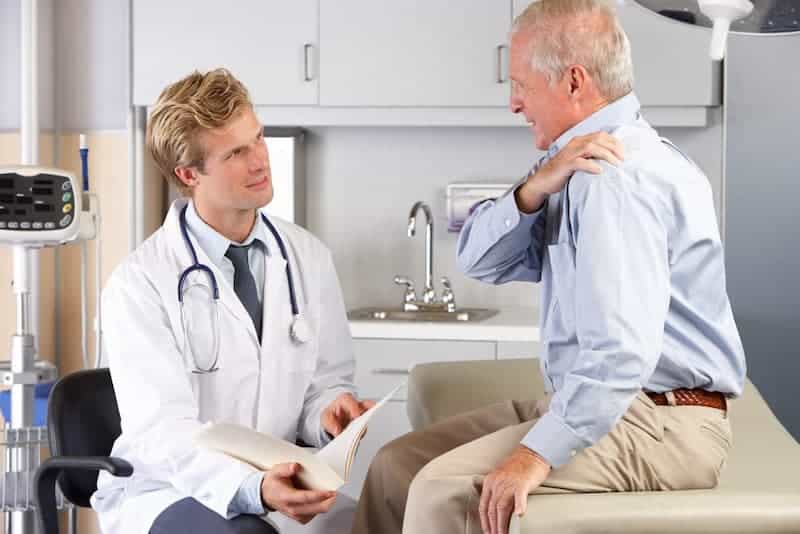
Postoperative pain management
During your operation, you will either be given a nerve block (interscalene block) or a local anesthetic around your wound. As a result, you shouldn't really feel significant pain when you wake up from anesthesia. If you experience any pain, your nurses will be able to administer an appropriate painkiller to relieve you.
When the time of action of the nerve block or local anesthetic has elapsed, you may begin to feel a small degree of discomfort. To avoid this discomfort, the anesthesiologist will prescribe oral painkillers. You may be asked to take them before the effect of the block or local anesthetic has passed. It is recommended to take them, as this will prevent pain completely or to a great extent.
Before you are discharged, you will be prescribed painkillers, or other medicines you need to have at home.
Postoperative immobilisation
Depending on the surgery you had, when you wake up from surgery, you will wear a brace or a sling. The type of sling may vary depending on the surgery you had. The length of time you need to wear the sling will depend on the type of surgery you had.
After any surgical repair of a torn tendon or ligament, either by suturing the ends together or reattaching them to the bone, it is desirable to avoid excessive stress or tension on the repair. On the other hand, the longer your shoulder is immobilized, the stiffer it is likely to become.
However, there is a period during tendon and ligament healing, where the repair is strong enough to begin to bear some load, although it is not yet fully healed. In fact, in order for a tendon or ligament to heal as strongly as possible, it must be placed under increasing load and tension, to allow for the tissues to remodel and mature.
Our rationale for the period of initial immobilisation, then followed by progressive mobilisation and strengthening after tendon - ligament repair is based on this assumption. We want to protect the repair at first, for as long as it takes to reach a safe level of healing, but then mobilise the shoulder as soon as it's safe, to avoid stiffness.
Furthermore, even immediately after a tendon or ligament repair, there are still some movements your shoulder can make that won't affect the repair. These are known as 'safe zones' of movement. This is something that physiotherapists will be able to guide you through, so that you can crack on with your rehab as soon as possible.
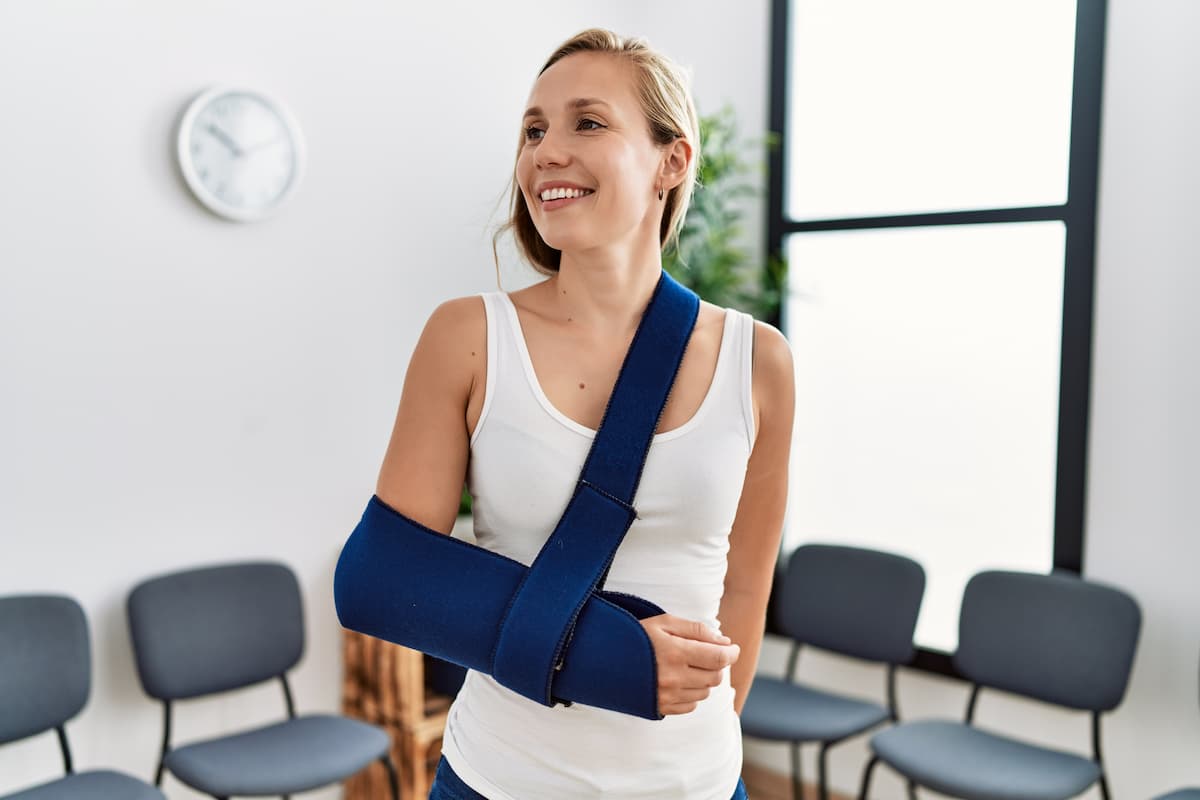
The surgical scar
At the end of the operation, your wound will usually be closed with a "subcutaneous" suture. It is a special type of suturing, under the skin, that has no knots and leaves a very neat scar. Some Steristrip tapes will be placed over the wound to help keep it closed and hold the stitches. A small bandage will then be placed over the wound. After most arthroscopic shoulder procedures there may be considerable swelling around the shoulder, and a temporary pad will be placed over the dressings to help absorb any residual fluid.
Before you go home, the ward nurse will remove your dressing and check that the wound is satisfactory. He will then re-cover the wound with a waterproof dressing and give you some replacement dressings to take home. It is safe to wash and shower with the dressings in place, but if the dressings become wet, you should remove them, dry the area and put on one of the spare dressings.
If for any reason, the surgical incision has stitches, these should be removed approximately 10 days after surgery.
After your stitches are removed, you will no longer need a bandage. You can wet the area without worry.
Αρθροσκόπηση ώμου επιπλοκές
Κάθε χειρουργείο έχει ρίσκα και οφέλη που θα πρέπει να ληφθούν υπόψιν προκειμένου να καταλήξουμε στην απόφαση να προχωρήσουμε. Οι επιπλοκές μπορεί να περιλαμβάνουν μετεγχειρητικό πόνο, δυσκαμψία, νευρική – αγγειακή βλάβη, υποτροπή της βλάβης, ιατρικές ή αναισθητικές επιπλοκές. Σε κάθε περίπτωση, η αρθροσκόπηση έχει χαμηλό ποσοστό επιπλοκών, σίγουρα χαμηλότερο από την παραδοσιακή ανοικτή μέθοδο.
Ανάρρωση μετά την Αρθροσκόπηση ώμου – Χρόνος Αποκατάστασης & Επιστροφή στην Καθημερινότητα
Postop rehab & exercises
After surgery, you will need physiotherapy and a home exercise program. Before leaving the hospital, our team will explain to you the specific rehabilitation program you should follow after surgery. They will show you how to safely put on and remove the sling, and how to dress and take care of yourself when your hand is on the sling.
Return to work after surgery
This largely depends on the type of work you do, whether you need to drive to work, and the type of surgery you did. In general, it's probably worth taking at least a week off from your regular job after any surgery, as a minimum.
Even if you need to put your arm in a sling after surgery, it is usually safe, when you are in a quiet environment, to take your arm out of the sling and use your elbow and wrist. This will allow you to safely eat, write and use a keyboard. The expected time to return to full duties after surgery varies, depending on the type of surgery and the nature of your work. It is best to discuss any questions and concerns you have about your expected post-operative recovery before surgery.
If you require a Medical Certificate for your work, this can be arranged by the Department before you leave hospital.
Driving after surgery
The time it takes for someone to be able to return to driving after shoulder surgery will depend on the type of surgery and length of immobilization (if required), as well as the course of recovery. To be able to drive safely, you should be able to actively move your shoulder, without assistance and without jeopardizing the tendon repair. You should be able to react normally to avoid injuring yourself or others due to a lack of control.
It is obvious that the driver must be able to use both hands to control the steering wheel. To achieve this, the driver needs to have sufficient strength and mobility in their shoulder.
It is the driver's responsibility to ensure that they are in control of the vehicle at all times. They should also be able to prove this if stopped by the police.
Drivers should check with the physiotherapist, surgeon and insurer involved in the vehicle's insurance policy before returning to driving after surgery.
Drivers must not drive under the influence of narcotic drugs, or within at least 24 hours after anesthesia administration.
To summarise:
- You are not allowed to drive with one hand only
- There is no exact time after surgery when you can return to driving. This is something that usually varies from person to person. However, the recommended amount of time your arm should be in a sling after surgery is definitely the MINIMUM time before you should consider returning to driving
- You can return to driving when you are able to move your shoulder without assistance and are able to drive safely and react appropriately in case of an emergency
- Although not necessary, it may be wise to discuss your return to driving with your insurance company
Read more on driving safely after surgery.
Return to sports after surgery
This largely depends on the type and level of sport or exercise you would like to return to, and the type of surgery.
The speed of recovery and progress for certain activity levels can vary between patients undergoing the same surgery. Your physical therapist, team doctor and coach will have to decide together when is the right time to return first to individual, then to group training, and finally to the game. Return, especially to contact sports, may require 4-6 months.
Αρθροσκόπηση ώμου: Κόστος – Πόσο στοιχίζει το χειρουργείο?
Το κόστος της επέμβασης περιλαμβάνει το αρθροσκοπικό υλικό, τα έξοδα παραμονής στο νοσοκομείο και την αμοιβή της χειρουργικής ομάδας. Το κόστος συνήθως είναι προσιτό και εξαρτάται από την πολυπλοκότητα της υποκείμενης παθολογίας και τα ειδικά υλικά που πρέπει να χρησιμοποιηθούν. Υπάρχει και συμμετοχή του ασφαλιστικού ταμείου του ασθενούς (ΕΟΠΥΥ). Οι ασθενείς με ιδιωτική ασφάλεια καλύπτονται σύμφωνα με τους όρους του ασφαλιστηρίου τους. Για περισσότερες πληροφορίες, επικοινωνήστε μαζί μας.
FAQs - Frequently Asked Questions
How soon can I return to sports after shoulder arthroscopy?
Complex answer that depends on many factors:
– The type of surgery (tendon repair, labial cartilage anchors)
– The type of sport (team vs individual, contact sports, etc)
When can I return to driving safely after surgery?
I must be able to drive safely & with both hands on the wheel & not be under the influence of narcotic painkillers.
When can I return to work after shoulder arthroscopy?
Complex answer that depends on many factors:
– The type of surgery (tendon repair, labral repair)
– The type of work (manual, office, supervisory, etc.)
What is the time of recovery after shoulder arthroscopy?
Recovery time can vary from a few days to several months, depending on the type of surgery and your individual progress in the recovery process.
Find us
Book an appointment with us today

